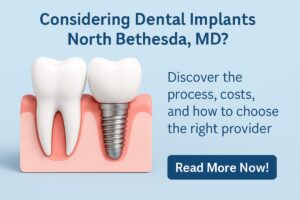Intro Full upper dental implants in Rockville, MD are a fixed tooth-replacement option for people missing most or all upper teeth. This guide explains full upper dental implants and is for patients wondering if implants are right for them. It covers candidacy, planning, procedure steps, recovery, benefits, risks, and next steps.
Who is a candidate for full upper dental implants?
Ideal candidates have multiple failing or missing upper teeth, trouble with removable dentures, or ongoing oral pain. Good overall health and reasonable jawbone volume make implants more predictable. Heavy smokers, uncontrolled diabetes, or active gum disease need special evaluation and treatment first.
Medical and oral health checks
We review your full medical history, current medications, and smoking status. Blood sugar control for diabetic patients is important. A digital periodontal assessment checks gum health, and digital x-rays or 3D scans evaluate bone height and tooth roots to see if implants are feasible.
How we plan full upper dental implants
Planning begins with a consult and 3D imaging so we can map bone and vital structures. For full upper dental implants in Rockville, MD we build a digital treatment plan to show implant number, angulation, and prosthesis type. This helps predict outcomes and timelines.
Custom treatment options
Options range from single-implant crowns (for isolated losses) to implant-supported bridges and full-arch prostheses. A full-arch prosthesis can be fixed or removable and may use 4–6 implants for support. We recommend the choice based on bone, budget, and patient goals.
The implant placement process for full upper dental implants
On surgery day you’ll have sedation options to stay comfortable. We place implants into the jawbone using minimally invasive tools that reduce cutting and swelling. Some patients receive a provisional prosthesis the same day (immediate loading); others wait for healing before attaching the final restoration.
Role of sedation and comfort
Sedation dentistry options like oral sedation or nitrous oxide help reduce anxiety and make the visit easier. Our team monitors comfort and safety throughout the procedure.
Recovery, aftercare, and timeline
Initial healing takes 1–2 weeks for soft tissue, while bone integration usually needs 3–6 months. Expect mild swelling and soreness managed with medication and a soft-food diet. Maintain gentle oral hygiene and follow rinsing instructions.
Follow-up and restoration phase
Follow-up visits monitor healing and implant stability. Once integrated, we attach the final prosthesis and adjust for fit and function. Expect several short visits for fine-tuning.
Benefits and risks of full upper dental implants
Full upper dental implants improve chewing, speech, facial support, and help preserve jawbone. They are durable and feel more natural than dentures. Risks include infection, implant failure, sinus complications, and the need for bone grafting in some cases. Seek prompt care for persistent pain, swelling, or fever.
Alternatives and cost considerations
Removable dentures cost less upfront but may slip and accelerate bone loss. Fixed bridges need healthy neighboring teeth. Costs vary by number of implants, bone grafting needs, and prosthesis type. Financing and insurance options can help manage costs.
Why choose State of the Art Dental Group for full upper dental implants
Dr. Kavish Gurjar trained at NYU with periodontal honors, is a Fellow of the International Congress of Implantologists, and has restored hundreds of implants. State of the Art Dental Group in Rockville, MD uses digital x-rays, minimally invasive equipment, and sedation systems to provide personalized, concierge care.
Quick FAQ and next steps
Q: Is the procedure painful? A: Sedation and local anesthetic keep pain low; soreness is typical after. Q: How long do implants last? A: With care, implants can last decades. Q: Am I eligible? A: A consult and 3D scan will tell us. Ready to learn if full upper dental implants in Rockville, MD are right for you? Call or request a consult to start a personalized treatment plan.




